

Posts Filtered by Tag - ATC |
Show Recent Posts
May 11, 2023
Update: Essential Trail Maintenance Workshop with the Appalachian Trail Conservancy
Update: Essential Trail Maintenance Workshop with the Appalachian Trail Conservancy
In 2022, the Allentown Hiking Club, in conjunction with the Appalachian Trail Conservancy, offered full-day workshops to review and teach trail maintenance standards to those eager to get involved and help maintain the Appalachian Trail. We are keeping an eye out for such opportunities in 2023 and beyond.

There are a variety of ways to get involved with the Trail and one fun way is to help with trail maintenance. Essential trail maintenance helps protect natural resources and improves the hiking experience. After grasping the basics, participants were better prepared to join future work trips with the AHC and ATC, and possibly adopt their own section of the Trail to maintain. Attendees gained valuable skills and conservation experience, benefited from a light workout, and got some quality time outside as they made the Appalachian Trail (AT) a better place.
With almost 2,200 miles of Trail spanning across the east coast from Maine to Georgia, the AT provides a place of sanctuary from the bustle of the modern-day world for both human and wildlife communities alike. Since its inception as the first National Scenic Trail 100 years ago, the A.T. has always depended on volunteers - people like you who are willing to contribute their time, interest, and skills in order to make it all possible. This training workshop introduced new and experienced participants to modern maintenance practices for use on the Appalachian National Scenic Trail. With a focus on safety, the course included topics covering: Trail Condition Assessment, Dealing with Water Issues, Brushing, Keeping Hikers on the Centerline, and Marking the Trail.
If you could not attend this year, keep an eye on our club calendar for next year or visit the AT's events page for additional opportunities: https://appalachiantrail.org/events/.

September 8, 2019
A Chance Encounter with Trail Maintainers in Maine
By Hal Wright
A Chance Encounter with Trail Maintainers in Maine
By Hal Wright
The man carrying a chainsaw to Little Bigelow Lean-to stuck out his hand and introduced himself: “Hi, I’m Hawk Methany.” My canine companion Sofia and I would stay at the lean-to that night, waiting out a thunderstorm which threatened to bring hale and high winds, on the third night of a six-day section hike.
I knew of Hawk, the ATC’s North Atlantic Regional Director, and joked that I was pleased to greet someone who is “AT famous.” Hawk was soon joined by Maine Appalachian Trail Conference Board Member Tom Carr, and ATC employees Paige Gregory and Dan Hale. Tom also serves as the MATC’s Hazard Tree Coordinator.
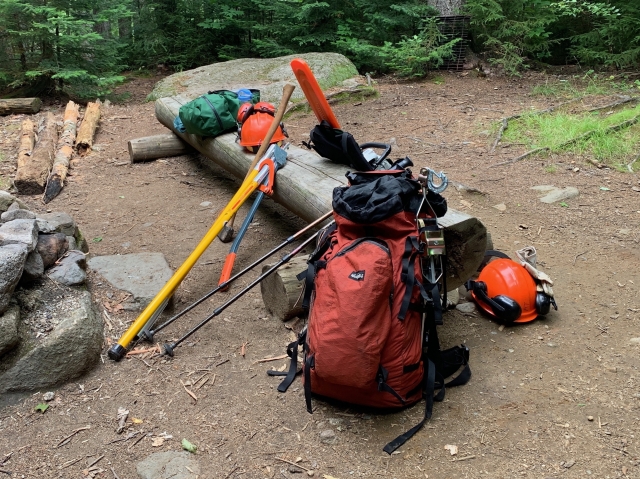
Everyone carried heavy tree-cutting equipment in and on top of backpacks. Their task was to cut down six hazardous trees which might fall, posing a risk to tent campers in the area of the shelter. Identifying the trees and cutting them down, using saws and tensioned ropes, took almost four hours of work.
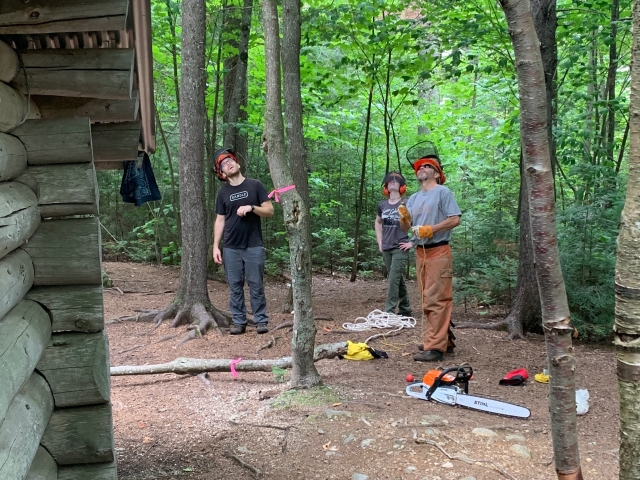
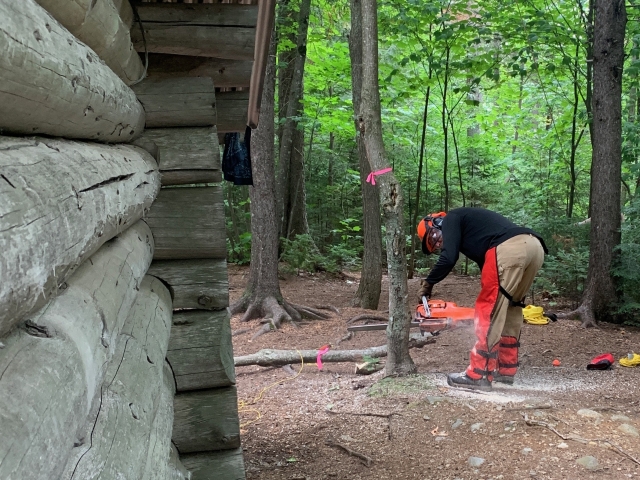
By the time the work was done, it had started to rain. The four packed up, said goodbye, and started the 1.5 mile journey back to the trailhead.
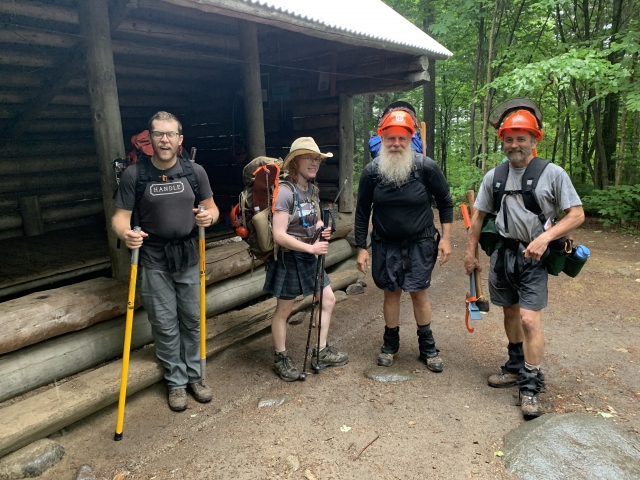
From left: Dan Hale, Paige Gregory, Tom Carr, Hawk Methany
As one thru hiker put it, “Maine is a giant stone with trees trying to grow on it.” Geology dictates the character of the Maine AT, creating streams to ford and random tangles of rocks, roots, and mud. But the hiker also encounters hundreds of bog bridges, and elegant flights of stairs made from nearby stones. As members of Allentown Hiking Club know, these and many other accommodations are the work of AT trail maintainers and builders, most of them volunteers from clubs along the trail.
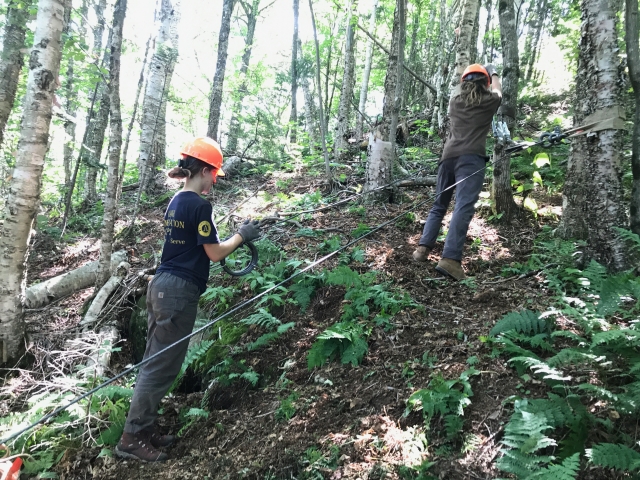
Moody Mountain, Maine. Maintainers rig a come-along and cables to position stone steps.
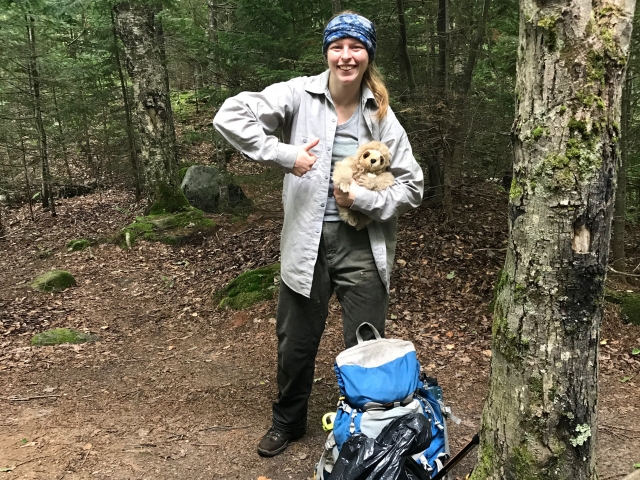
Bree is an Appalachian Mountain Club employee who tends to the campsites in New Hampshire and southern Maine.

February 19, 2019
The ATC 2018 Biennial Conference
by Cynthia Paetow and Agnes Sablow
The ATC 2018 Biennial Conference
by Cynthia Paetow and Agnes Sablow
The Appalachian Trail Conservancy’s (ATC) written mission is “to preserve and manage the Appalachian Trail – ensuring that its vast natural beauty and priceless cultural heritage can be shared and enjoyed today, tomorrow, and for centuries to come.” We were excited to be a part of the ATC conference this year and to learn how much this organization does for the hiking community.
One of the things that stood out is the number of clubs, organizations, governments and individuals that work together for the benefit of the Appalachian Trail (AT). One of the AT’s core values is Cooperation. We had speakers from A.T. Communities, the AT Park Ranger, ATC Board members, Youth Representatives and so many more. There are a multitude of groups, organizations, governments and individuals working hard behind the scenes to maintain this trail that we all enjoy.
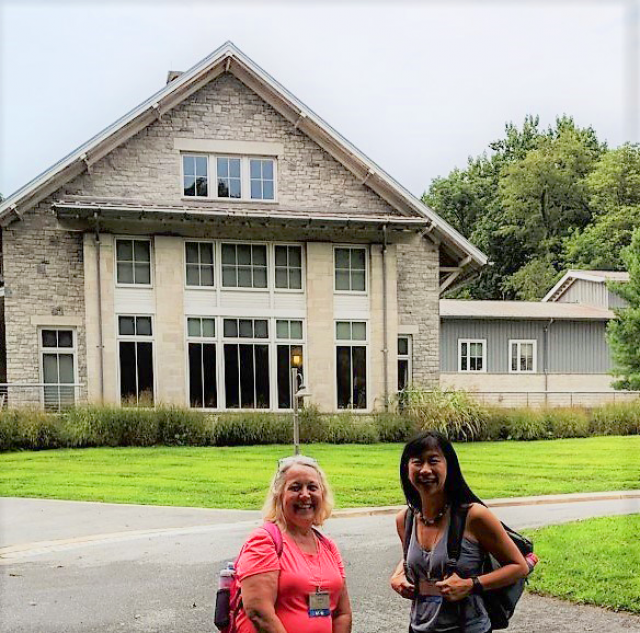
The focus for much of the weekend was on getting new people outside hiking on and maintaining our trails. Diversity in race, ethnicity, age and abilities was discussed and we were encouraged to look at our own groups and networks. Some ideas included offering specialty events such as those for young adults or family hikes to bring out adults and children together. History or cultural hikes were mentioned as well as reaching out to other diverse groups in our area.
Overall, we think our club is on the right track. Like many other clubs, we have an aging membership, but like any established group, it has its ebbs and flows. Our schedule is currently filled with many different kinds of activities from short city walks to long strenuous hikes, from kayaking to camping and a variety of cultural treks, maintenance hikes and social activities. We have daytime, evening and weekend hikes of various lengths. Our Meetup and Facebook pages have added to our Club Page, bringing in new attendees and members.
Our club can also utilize the ATC website. In fact, the ATC encourages us to list all our maintenance events on their website which is another way for people to find us. Logging all of our volunteer hours maintaining the AT is extremely important in continuing to obtain funding for the AT. The more hours that are logged and submitted shows the government how much work it takes to maintain the trail. The ATC can also “compete for a significant amount of NPS [National Park Service] funding from its national “Volunteer in the Parks” program.” So, when our Appalachian Trail Chair, Ed Ritter, asks us for our volunteer hours, please make sure he gets those.
Finally, we would encourage everyone to visit the ATC website. There is so much information there that we could not even begin to cover. Whether you are an active hiker, someone trying to get back into shape, someone who wants to help maintain the trail or someone who can no longer hike but wants to support the Appalachian Trail, there is something for everyone.
Hope to see you all soon on a hike, at a meeting or working together on a maintenance activity.

POSTS BY TAG
POSTS BY MONTH